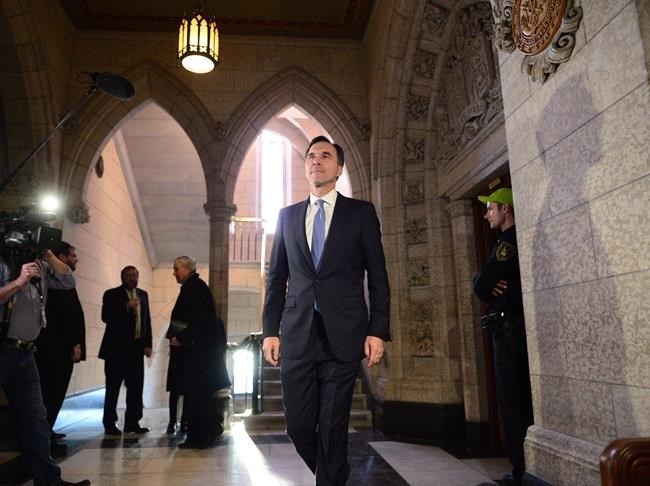
Finance Minister Bill Morneau arrives to talk to media on tax changes for small businesses in Ottawa on December 13, 2017. A new report from the federal Finance Department says better-than-expected economic growth in 2017 shaved several years of projected deficits from Canada's long-term financial future -- though many more years remain. The report predicts that barring any policy changes, the federal government could be on track for annual shortfalls until 2045-46, compared to projections last year that deficits would run to 2050-51.
Image Credit: THE CANADIAN PRESS/Sean Kilptarick
December 23, 2017 - 1:00 PM
OTTAWA - The federal Finance Department has shaved several years of projected deficits from Canada's long-term financial future following better-than-expected economic growth in 2017 — though many more years of deficits remain.
Finance officials predicted in a report released Friday that barring any policy changes, the federal government could be on track to run annual shortfalls until 2045-46, compared to projections last year that deficits would run to 2050-51.
If such a scenario played out, the deficit would reach an annual high of $24.8 billion around 2030-31 before beginning to fall.
By 2040-41, the federal debt would top out at around $1.08 trillion before starting to fall, as compared to last year's prediction that it would reach $1.55 trillion by 2050-51.
The improvement is attributed to an overall boost in the fiscal outlook, particularly in the medium term, which comes after the Canadian economy mounted a surprise resurgence over the past 12 months.
While long-term predictions contain considerable uncertainty, Finance Minister Bill Morneau nonetheless said the projections prove the Liberal government's plan is bearing fruit.
"We have an ambitious plan to grow Canada's economy by investing in people, growing the middle class and helping those working hard to join it," Morneau said in a statement Friday. "Our plan is working."
The Liberals won the 2015 election on a plan to spur economic growth by running annual deficits of no more than $10 billion over the first couple years to pay for infrastructure investments before balancing the books in 2019-20.
But they abandoned those so-called "fiscal anchors" as the economy took a beating from collapsing oil prices in 2016, and have instead focused on lowering the debt-to-GDP ratio, which is a measure of Ottawa's debt burden.
The Liberals have not set a timeline for a return to balance.
The Finance report emphasized investments in skills and technology as it warned that Canada's aging population will contribute less to the economy and instead become a drain on public finances in the coming years.
That warning largely explained why the GDP was projected to see slower growth between 2023-2055 than in previous decades, going back to 1950.
"It is therefore imperative to continue to grow the economy by investing in the middle class and in the skills and technology that will make Canada more productive, competitive and fair," the report read.
"In particular, improving the economic participation of groups traditionally under-represented in the labour market, including women, Indigenous people, older workers, newcomers and persons with disabilities, is key to Canada's long-term fiscal and economic performance."
News from © The Canadian Press, 2017